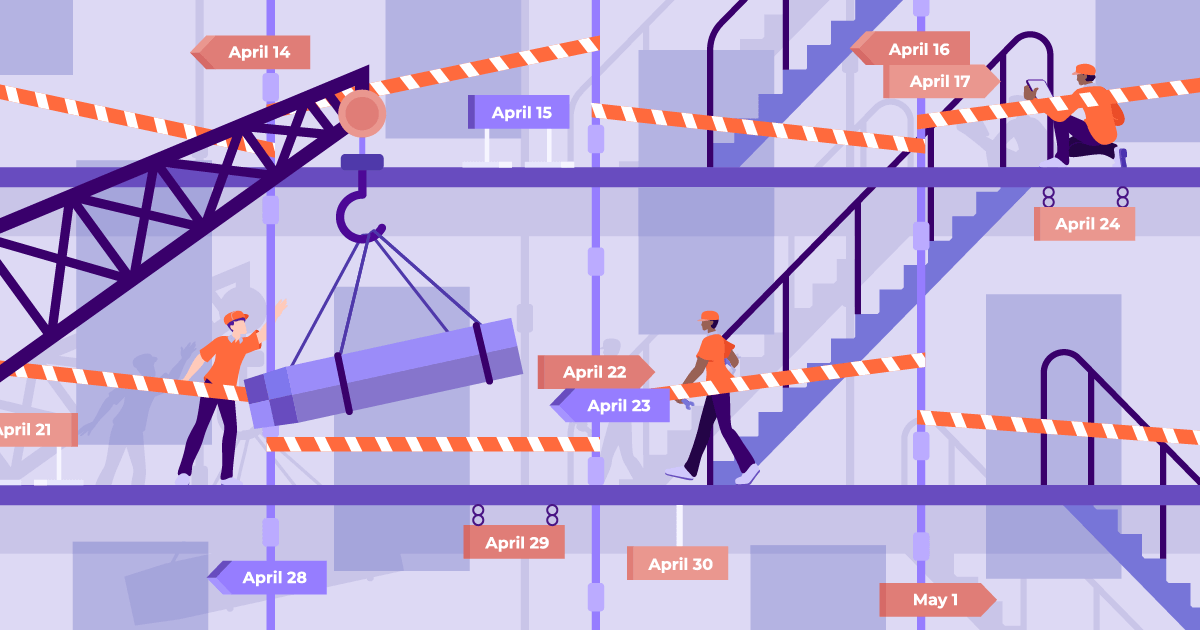Addressing Reactive Maintenance Challenges: Strategies for Unplanned Repairs

In the intricate world of asset management, one term that often strikes fear into the hearts of maintenance teams is “reactive maintenance.” It’s the unscheduled, unexpected, and often unwelcome part of asset care that can send budgets spiralling and operations into disarray. Reactive maintenance, simply put, is the practice of fixing things when they break.
In this blog, we’ll delve into the world of reactive maintenance, exploring its definition, the scenarios where it’s necessary, and the pros and cons it brings to the table. But we don’t stop there; we also examine how technology is revolutionising the management of reactive maintenance, the common challenges faced, and most importantly, the strategies to overcome them. Plus, we’ll take a glimpse into FieldInsight’s capabilities in effectively managing reactive maintenance, ensuring that unexpected repairs don’t become a chaotic nightmare.
Let’s dive into breakdown maintenance, how you can better manage your maintenance team, and define your corrective maintenance strategies.
What is Reactive Maintenance?
Definition: A reactive maintenance approach is essentially the practice of repairing assets when they break or fail. It represents a maintenance strategy that reacts to issues as they arise, rather than actively preventing them through scheduled inspections or routine upkeep. This approach stands in stark contrast to preventive maintenance, which prioritizes proactive measures to identify and rectify potential problems before they lead to breakdowns. Reactive maintenance, often characterized as a “break-fix” strategy, hinges on addressing problems in a responsive rather than a preventive manner.
When is it Necessary: The necessity for reactive maintenance often arises in situations where asset failure is inherently unpredictable or when the costs associated with preventive maintenance outweigh the expenses related to responding to breakdowns. In essence, reactive maintenance becomes the preferred choice when the risks and costs of addressing issues before they occur surpass the financial benefits of regular preventive care. For instance, some equipment or systems may be more cost-effective to run until failure and replace afterward, as investing in regular maintenance might be less economical.
Pros and Cons: Reactive maintenance offers immediate cost savings by eliminating the need for routine preventive inspections and upkeep. This can be advantageous in terms of initial budgetary constraints and resource allocation. However, it comes with significant drawbacks that organizations must carefully consider. Chief among these drawbacks is the issue of unplanned downtime, which can disrupt operations, delay projects, and result in revenue loss. Additionally, higher repair costs are associated with reactive maintenance, as addressing issues post-breakdown often requires more extensive and costly repairs compared to planned maintenance. Lastly, there is the concern of potential safety risks, as rushed maintenance tasks and unexpected breakdowns can create hazardous situations for personnel and the surrounding environment. Overall, while reactive maintenance may seem cost-effective in the short term, its long-term financial implications and operational disruptions necessitate a balanced approach that combines reactive and preventive strategies as warranted by specific circumstances.
Technology’s Role in Managing Reactive Maintenance
In the age of technology, we can’t talk about reactive maintenance without acknowledging the transformative impact of cutting-edge solutions:
- Real-time Monitoring: Technology enables real-time asset monitoring, allowing immediate issue detection and quicker response times. Sensors and monitoring systems keep a watchful eye on asset performance, sending data to a centralised platform for analysis.
- Automated Alerts: Automated notifications ensure that maintenance teams are instantly alerted when an issue arises, reducing response time and minimising the impact of failures. This feature is crucial for preventing minor issues from escalating into major problems.
- Data Analytics: Historical data and predictive analytics help in better preparing for potential reactive maintenance scenarios. By analysing past incidents, businesses can identify patterns and trends to anticipate future breakdowns. This data-driven approach empowers organisations to make informed decisions and allocate resources more effectively.
Common Challenges in Reactive Maintenance
Reactive maintenance brings its own set of challenges that can make even the most seasoned asset managers break a sweat:
- Urgency and Time Constraints: Reactive maintenance is often time-sensitive, requiring quick response and action to minimise downtime. When an asset fails unexpectedly, every minute counts, and the pressure is on to get it back up and running.
- Resource Allocation: Mobilising the right resources on short notice can be a logistical nightmare, affecting response times and efficiency. Maintenance teams need to be dispatched promptly, with access to the necessary tools and spare parts.
- Cost Implications: Reactive maintenance can often be more expensive than planned maintenance due to emergency repair costs and potential damage caused by delays. The immediate expenses of reactive maintenance can quickly add up, impacting the budget significantly.
- Safety Risks: Rushed maintenance tasks carry the potential for safety hazards, further emphasising the need for careful planning. Ensuring the safety of maintenance personnel while addressing urgent issues is a critical concern for organisations.
Strategies for Overcoming Reactive Maintenance Challenges
To tackle the challenges of reactive maintenance head-on, businesses should consider implementing the following strategies:
- Emergency Protocols: Establish a well-defined emergency response plan, ensuring that everyone knows their role and responsibilities during unexpected breakdowns. Having a clear protocol in place helps streamline decision-making and response efforts, reducing confusion and delays.
- Skilled Rapid-Response Teams: Develop specialised teams trained to handle emergency maintenance efficiently, equipped with the skills and knowledge to make quick decisions. These teams should be well-versed in safety procedures and possess the expertise needed to address a range of potential issues.
- Spare Parts Inventory: Maintain an updated inventory of essential spare parts to minimise downtime when replacements are needed. Keeping a well-organised inventory ensures that critical components are readily available, reducing the time it takes to restore an asset to working condition.
- Communication: Ensure clear and quick communication channels among team members and stakeholders to streamline decision-making and execution during emergencies. Effective communication is essential for coordinating efforts and ensuring that everyone is on the same page.
The Financial Impact of Preventive Maintenance VS Reactive Maintenance Strategy
The financial impact of preventive maintenance versus reactive maintenance is a pivotal consideration for businesses. Preventive maintenance, with its scheduled inspections and upkeep, often incurs upfront costs. However, these expenses are typically lower than the exorbitant emergency repair bills associated with reactive maintenance.
Preventive maintenance aims to identify and address potential issues before they escalate, reducing the risk of unexpected breakdowns and the associated downtime costs. In contrast, reactive maintenance may seem cost-effective in the short term, but it can lead to substantial financial repercussions over time. Unplanned downtime, operational inefficiencies, and the long-term wear and tear on assets can significantly inflate the total cost of ownership. Therefore, while preventive maintenance requires an initial investment, it serves as a prudent financial strategy in the long run, minimising disruptions, enhancing asset reliability, and ultimately reducing overall maintenance expenditures.
The financial ramifications of reactive maintenance can be significant and far-reaching:
- Unplanned Downtime: Unexpected asset downtime disrupts operations and can result in lost revenue, customer dissatisfaction, and increased operational costs. When critical assets fail without warning, the immediate impact can be felt throughout the organisation.
- Operational Inefficiencies: Reactive maintenance can disrupt regular operations, leading to inefficiencies and reduced productivity. Teams may need to divert their focus from planned tasks to address urgent issues, causing delays and bottlenecks.
- Long-Term Costs: Frequent reactive maintenance can have long-term financial repercussions, including higher maintenance costs and shortened asset lifecycles. While it may seem cost-effective in the short term, relying solely on reactive maintenance can lead to increased spending over time.
How FieldInsight Can Help
FieldInsight steps in as a reliable partner in managing reactive maintenance with its array of features:
Centralised Management: FieldInsight’s platform centralises reactive maintenance tasks, streamlining processes and ensuring that all information is readily available in one place. With a unified platform, maintenance teams can access data, track progress, and coordinate efforts more effectively.
Quick Responsiveness: FieldInsight enables rapid response to maintenance issues through automated alerts and real-time monitoring, helping teams address problems before they escalate. With instant notifications and real-time data, maintenance personnel can take immediate action to prevent further damage and downtime.
Data-Driven Decisions: Even in emergency scenarios, FieldInsight empowers businesses to make informed decisions by providing access to historical data and predictive analytics. By leveraging data-driven insights, organisations can allocate resources more efficiently and develop proactive strategies for reactive maintenance.
Key Takeaways for Your Reactive Maintenance Strategy
In conclusion, reactive maintenance is an inevitable aspect of asset management, but with the right strategies and technology at your disposal, it doesn’t have to be a daunting challenge. Being prepared for reactive maintenance challenges is crucial, and the adoption of technology solutions like FieldInsight can make a world of difference in effectively managing unexpected repairs. From scheduling maintenance services, emergency repairs, equipment failure, and more, you can access everything you need in the one place.
By leveraging the power of technology, businesses can minimise the financial impact, reduce downtime, and ensure that unplanned maintenance doesn’t turn into a chaotic nightmare. In a world where the unexpected is a constant, proactive preparation can be the difference between smooth operations and costly disruptions.
What You Should Do Now
- Book a Demo. You’ll be in touch with an automation expert who has worked in this space for over 5 years, and knows the optimal workflow to address your needs.
- If you’d like access to free articles about managing HVAC workflows, go to our blog.
- If you know someone who’d enjoy reading this page, share it with them via email, Linkedin, Twitter, or Facebook.









